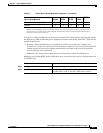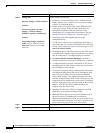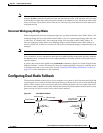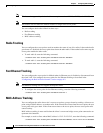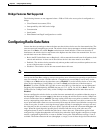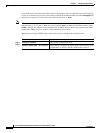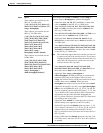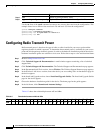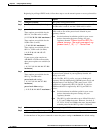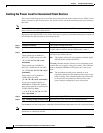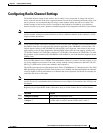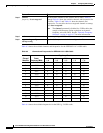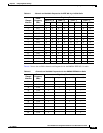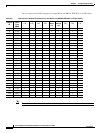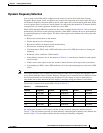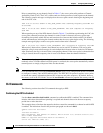
6-11
Cisco IOS Software Configuration Guide for Cisco Aironet Access Points
OL-11350-01
Chapter 6 Configuring Radio Settings
Configuring Radio Transmit Power
Beginning in privileged EXEC mode, follow these steps to set the transmit power on access point radios:
Use the no form of the power command to return the power setting to maximum, the default setting.
Command Purpose
Step 1
configure terminal Enter global configuration mode.
Step 2
interface dot11radio { 0 | 1slot/port
}
Enter interface configuration mode for the radio interface. The
2.4-GHz radio is radio 0, and the 5-GHz radio is radio 1.
Step 3
power local
These options are available for the
802.11b, 2.4-GHz radio (in mW):
{ 1 | 5 | 20 | 30 | 50 | 100 | maximum }
These options are available for the
5-GHz radio (in mW):
{ 5 | 10 | 20 | 40 | maximum }
These options are available for the
802.11a, 5-GHz radio (in dBm):
{-1 | 2 | 5 | 8 | 11 | 14 | 15 | 17 |
maximum }
If your access point contains an
AIR-RM21A 5-GHz radio module,
these power options are available (in
dBm):
{ -1 | 2 | 5 | 8 | 11 | 14 | 16 | 17 | 20 |
maximum }
Set the transmit power for the 802.11b, 2.4-GHz radio or the
5-GHz radio to one of the power levels allowed in your
regulatory domain.
Note See the hardware installation guide for your access
point to determine the power settings for your
regulatory domain.
“Power local for 802.11b -
please remove. No such command, e.g.
power local {1 | 5 | ....}” - Tania Chen
Step 4
power local
These options are available for the
802.11g, 2.4-GHz radio:
power local cck settings:
{ -1 | 2 | 5 | 8 | 11 | 14 | 17 | 20 |
maximum }
power local ofdm settings:
{ -1 | 2 | 5 | 8 | 11 | 14 | 17 |maximum }
Set the transmit power for the 802.11g, 2.4-GHz radio to one of
the power levels allowed in your regulatory domain. All
settings are in mW.
On the 2.4-GHz, 802.11g radio, you can set Orthogonal
Frequency Division Multiplexing (OFDM) power levels and
Complementary Code Keying (CCK) power levels. CCK
modulation is supported by 802.11b and 802.11g devices.
OFDM modulation is supported by 802.11g and 802.11a
devices.
Note See the hardware installation guide for your access
point to determine the power settings for your
regulatory domain.
Note The 802.11g radio transmits at up to 100 mW for the 1,
2, 5.5, and 11Mbps data rates. However, for the 6, 9,
12, 18, 24, 36, 48, and 54Mbps data rates, the maximum
transmit power for the 802.11g radio is 3050 mW.
Step 5
end Return to privileged EXEC mode.
Step 6
copy running-config startup-config (Optional) Save your entries in the configuration file.



